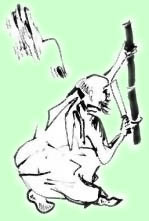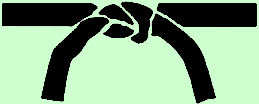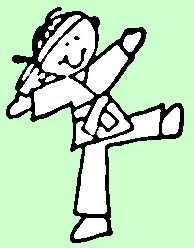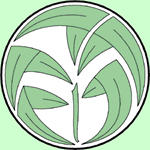Aoinagi Karate-Do


Self-Development through Self-Defense
Aoinagi Karate-Do at Loma Linda
Being in the Drayson Center of Loma Linda University
General Information
Aoinagi Karate-Do Loma Linda is a recreation class of Loma Linda University. It is held by the recreation department and is housed in the fabulous new Drayson Center.
The Loma Linda Dojo was opened in 1972. The training emphasis is martial arts, not martial techniques. We believe that through these arts a practitioner may learn far more than just what appears on the surface in fighting or competition.
The philosophy of the class blends well with the Seventh-Day Adventist way of life including non-violence, respect for life, and healthy living.
There are no age limits at the present time but prospective students must be able to hold attention without losing interest. This generally occurs at around seven years old. The oldest student who began to train at Aoinagi Karate-Do was 82 years old. Just about any aged person can learn Aoinagi Karate if the person has the desire.
 |
"One who has attained mastery of an art reveals it in
every action." – Samurai maxim |
About the Instructors
Julie Evans
Mrs. Julie Evans is a fifth-degree black belt in Aoinagi Karate-Do and has been training for over 19 years. She has completed the Instructors Course of Aoinagi Karate-Do. Mrs. Evans has been teaching martial arts since 1982 and is a chief instructor at Aoinagi Karate-Do.
Mrs. Evans is a student of O'Sensei Richard Kim of the Butoku Kai, one of the oldest martial arts organizations in Japan.
Mrs. Evans has also studied judo, several of the traditional weapons of Okinawa, and the sword and naginata of Japan. Mrs. Evans is a practicing attorney in San Bernardino in family law and received some of her education in the Seventh-Day Adventist school system.
Peter Gold
Dr. Peter Gold is a fifth-degree black belt in Aoinagi Karate-Do and has been training for over 20 years. He has completed the Instructors Course of Aoinagi Karate-Do. He has been teaching martial arts since 1981 and is a chief instructor at Aoinagi Karate-Do.
Dr. Gold is a student of O'Sensei Richard Kim of the Butoku Kai, one of the oldest martial arts organizations in Japan. Dr. Gold has also studied judo, several of the traditional weapons of Okinawa, and the Japanese sword.
Dr. Gold is a practicing attorney in San Bernardino in family law, bankruptcy, guardianships and adoptions. He is a graduate of Loma Linda University where he received his doctor of philosophy.
 |
"A strong wind may destroy a sturdy tree; but the willow
bends and the wind passes through." – Gichin Funakoshi |
Contact Information
Studio B
Loma Linda Drayson Center
25040 Stewart Street
Loma Linda, California 92354
Loma Linda is about 60 miles East of Los Angeles and five miles South of San Bernardino, California.
- From Freeway 10 while travelling Eastbound
- Exit on Tippecanoe/Anderson Street
- Turn right at the bottom of the freeway exit
- Go over the railroad overpass
- At the bottom of the railroad overpass turn left on Stewart Street (a traffic light)
- Drayson Center is on the left side of Stewart Street about half a mile East of Anderson Street.
- Once inside the building pass the security check and ask for Studio B.
For registration information: (909) 824-4975
For karate-specific information: Loma Linda Aoinagi Karate-Do

Days and Times
Mondays and Wednesdays from 5:00 PM until 7:00 PM
Fees
All fees are paid to the Drayson Center.
Currently the Drayson Center charges $60.00 for a ten-week session (20 classes).

Belt Testing
Belt testing is usually held the last two classes of the ten week session. Sometimes a test may be held on a Sunday because of class time restraints.
Loma Linda Dojo Children's Class

Children are special people. Loma Linda Aoinagi Karate-Do has a special class for children.
Children often have difficulty maintaining attention for more than a few minutes. For this reason, the children's class varies considerably. As a matter of fact, when there are more than one instructor, which is the usual case, the children rotate through a variety of activities and subject matter changes. This keeps a variety of lessons appearing and a variety of different instructors stimulating the children's interest.
This variety is done so that the interest of the children is maintained. In general, the class has warm-ups, basics, moving basics, kata, self-defense and sparring techniques. All activities are non-contact and all children are told of this rule before being allowed into any practice with partners. Failure to abide by non-contact practice may result in dismissal from Aoinagi Karate-Do.
Many of the current members of Aoinagi Karate began as children and now are black belts.
Loma Linda Dojo Adult Class

Typically this class begins with warm-ups for a few minutes although it is best for the student to come early and warm-up before class begins. Kihon (basic practice) comes next and may take a considerable portion of the class. Kihon often includes undoo (moving basic practice) where students move forward, backward and execute turns, jumps or falls.
Kata (formalized sequences) usually follow kihon. The kata are solo exercises consisting of series of fighting techniques and postures that simulate a fighting situation. Kata practice in this class emphasizes correct form, balance, speed, power, timing, attention to detail, concentration, and fighting spirit.
Practice with partners aids in development of fighting ability. Cooperative and careful students are encouraged to participate in practice with partners (kumite). Practice with partners in this class takes the format of pre-arranged techniques and self-defense techniques.
Instructors occasionally give discussions and lectures on martial subjects such as history, martial arts philosophy, body dynamics, self-defense, conflict negotiation and stress reduction. The object of these discussions is to get the student to a point of understanding of martial subjects so that the student will be able to answer questions on the black belt written and oral examinations.
Occasionally, a Christmas party potluck, awards banquet, field trip, tournament, conjoint training with other Aoinagi Karate schools, weekend training, or a gasshuku (which is essentially a camping trip) will be scheduled. These activities provide opportunities for additional training and social interaction. Students are encouraged to attend these extracurricular activities.

AOINAGI KARATE-DO
Come train with us!
|
March 8, 1972.
Loma Linda University, Loma Linda, California,
USA.
Eight students began to study a little known means of
self- defense called goshin-jitsu. They were crammed into a lecture room
on the bottom floor of Gentry Gymnasium/Auditorium.
There was one
woman, Nori Khoo. The rest were men; Peter Triolo, Fred Knight, Larry
Allen, John Carothers and three others. Most of them were either medical
students or dental students.
"I just came here out of curiosity.
What does karate mean," asked Fred Knight.
I've been trying to
answer that question ever since.
The beginning of Aoinagi Karate-Do was rather uneventful. By
June 1972 the eight beginning students had earned their orange belts.
Suddenly, they all quit. I didn't see them again for years. Some of them I
have never seen since. I should have taken heed then; people leave karate
quickly without warning.
But, I didn't take the hint. I continued
to teach. New students came, then left. Hundreds of students passed
through the doors, then thousands. Only a few stayed as long as a year. I
just kept teaching those who wanted to learn.
And some learned; and
some learned very well.
Aoinagi Karate was born, not
at a place or at a time, but was born in the hearts of the few who
stayed.
|
Aoinagi is an American pronounciation of the Japanese words
These words, as you can see, are two characters. The first
character is AOI. It means green in Japanese. It may be pronounced as aoi,
aoy, or, believe or not sei.
The second character is yagi. It means
willow tree. It may be pronounced yagi, nagi, or ryu.
Taken
together the two words make aoinagi, aoiyagi, aoyagi or seiryu. They all
mean the same; the green willow tree.
And, that is the meaning of
the word AOINAGI.
|
When other martial arts schools call themselves fanciful names like
Flying Dragon Society, or Bill's Full Contact Kick-Boxing why would we
have selected such a name as the green willow tree? The answer is not
obvious, but there is an answer. Let's look.
There are 350 species
of willows in the world. They grow in every conceivable biome. They live
at the edges of lakes in the highest mountains of the world. They live in
dry waterholes in the middle of the great Mojave desert. They grow beyond
the last tree at tree line in the tundra of Alaska. These plants are
widespread. And yet they really don't push other things around. They just
live, taking in nutrients, giving off oxygen that other organisms might
live. They just fit into the ecosystems of the world.
Willows are
also exceedingly persistant. Their roots often survive a wildfire and grow
back the next year with luxuriant foilage. Droughts may kill off the
surrounding vegetation but the willow grows at the first drops of rain. If
you cut out their roots a few remaining ones regrow to reproduce an entire
stand of willows again. This is persistence, an admirable
quality.
In view of the willow's non-aggression and yet persistence
in the face of overwhelming odds, the name was selected for the
organization which we call AOINAGI.
We don't claim to be the
biggest organization, nor the best martial art in the world, or even the
best in California. We claim only to be. And some of what we are we take
from the image of a green willow tree growing wild and
free.
|
1) How does Aoinagi differ from other martial arts schools?
Martial arts vary with differences in their origin and style. Aoinagi teaches traditional Japanese Okinawan Shito-ryu style karate. This is one of four major styles of Japanese karate. The Aoinagi school was founded in 1972 by Sensei Raymond Castilonia, and has several branches around the U.S.
2) Where does the term Aoinagi come from and what does it mean?
Aoinagi literally means "the green willow tree". Willow's have a remarkable ability to survive where little else can. The name "Aoinagi" was chosen to reflect this persistence to life.
3) What is a typical class like? How often do they meet?
At the start of a typical class, the students line up in belt rank order. Then everyone warms up as a group, or sometimes on your own. There is normally a period of practice on basics or fundamentals, work on kata (predefined forms), and/or kumite (fighting techniques with an opponent). Class is dismissed from a final line up. Classes often vary quite a bit, no two trainings are exactly the same. Classes typically meet twice a week for one hour or more.
4) How is Aoinagi sanctioned?
An organization named the Zen Bei Butokukai sanctions about a hundred martial arts schools in America including Aoinagi Karate. Its headquarters is located in Sacramento, California and its president is Dr. Richard Kim, PhD.
In addition the Zen Bei Butokukai is sanctioned as the American representative of the Dai Nippon Butokukai (Greater Japanese Martial Ways Organization), located in Kyoto Japan.
The Dai Nippon Butokukai is an eclectic martial arts organization. It has masters who specialize in karate (since 1935), judo (since 1895), aikido (since 1930), and the more ancient and traditional martial arts of kenjitsu (sword), bojitsu (long staff), naginata (halberg), kyujitsu (archery), and others.
5) What kind of a background does the instructor have?
The Sensei or "teacher" is issued a license by the Zen Bei Butokukai. This license reflects many years of experience and a very high degree of proficiency in the art.
6) Does Aoinagi karate have any religious implications?
In short, no, you'll not be indoctrinated into any mystical eastern religion.
Aoinagi karate training will encourage you to develop character and develop your entire being (body, mind, and spirit). This may sound "religious" because this development encompasses a spiritual component. You'll be encouraged to develop spiritually, but you'll not be told how to do it, that's up to you.
7) Will I get hurt during training, will I possibly injure others?
Injuries are rare. Injury is always a possibility but Aoinagi is a "non-contact" school and every precaution is taken to avoid injury. One might incorrectly conclude they could not learn fighting techniques well at a non- contact school. In reality, you will learn greater control in a non-contact environment.
8) I don't want to violate any protocol, what should/shouldn't I do?
"Always treat your training, instructors, and fellow students with respect." Keep this one thought in mind and you'll be fine. To show your respect, please bow at the doorway when entering and leaving the dojo (the place where class is held) and upon entering and leaving the training floor.
9) How much should I practice at home to do well?
Practice outside of class makes a world of difference for the karate student. Many short sessions are preferable to marathon sessions. Frequent review helps you to really internalize the techniques. A student that reviews a few (5-15) minutes several times a week will progress nicely. Of course, more review and practice is better.
10) What other materials are available (books, videos, etc.)?
In general, your best way to learn is to come to the classes where you will receive instruction, watch others, and ask questions. However, there are several books that are available that give insight into karate training. Sensei Castilonia has an excellent book about Aoinagi entitled "Nuggets In The Ground". There are some homemade videos around which are most beneficial to the new student to help them review the mechanics of the basic techniques.
11) How long does it take an average student to earn a black belt?
Naturally this depends on the student, their aptitude and more importantly, their diligence in training. An average time for first degree black belt is between 3 and 5 years.
12) As a black belt in karate will I be required to register my hands and feet as deadly weapons?
No. None of the blackbelts at Aoinagi Karate have ever been required nor requested to register their hands or feet as deadly weapons by any government organization such as police, sheriff, state police, FBI, CIA or other law enforcement agency.
13) How many different colors of belts are there before black belt?
There are ten belt ranks before black belt. Every student starts out training as a white belt. The first belt the student earns is an orange belt which takes about three months of regular training. Then there are two levels of blue, two levels of purple, two levels of green, and three levels of brown belt before a student tests for black belt.
14) Why does Aoinagi place an emphasis on Kata (forms practice)?
Kata are of paramount importance within Aoinagi Karate. Each Kata has a central theme that may be natural, moral, mathematical or supernatural. Some examples of the themes kata deal with are such things as the five levels of peace, wind in the pine trees, respect for elders... there are many. Through constant practice, the student learns to emulate the theme of the kata as he or she performs it. Most importantly, Kata training builds the spirit of the student. It is said that kata are a form of ``moving meditation'' which raises the student to higher levels of awareness. The kata experience transforms the student from a technician to a martial artist.
15) Do students compete in tournaments?
Yes, they are encouraged to do so. Aoinagi holds at least one tournament each year for it's own students. The Aoinagi tournament includes many different events such as kata, weapons kata, and various team events. Aoinagi students occasionally participate in other-than-Aoinagi karate tournaments and have been selected to compete at US National, PanAmerican and World Championships.
16) How many forms or kata are in your system?
We have 54 distinctive forms in our system, but our school often teaches several others and some weapons forms too.
17) Do you spar?
Yes, but it is quite different since we are a non-contact school. Sparring is not the emphasis of our training. When we do spar we are working on timing and looking for targets; however, we stop a few inches short of executing any contact in our major techniques.
18) What is all that yelling and screaming about when you practice karate?
During karate training we often will yell or kiai to concentrate our focus and increase our energy at the moment of impact for a strike. The yell will insure we have tightened our stomach muscles and are better able to take a punch, as well as adding force to the technique we are delivering.
19) Could you please explain what a "kata" is in more detail?
A kata is a form of predetermined moves against imaginary opponents lasting 45 to 60 seconds. Kata vary in complexities but involve offensive and defensive martial techniques designed to teach a practitioner the fundamentals of martial arts. The arrangement and selection of the moves by the creator classically represents years of study into a theme. Through years of practice the kata can become greater than the sum of the techniques.
20) As a beginning student, am I in good enough physical condition to begin training in karate?
Only you and your physician can answer that question definitively. We encourage all new students to obtain a physical examination from your health care provider before beginning any exercise program or new physical activity including Aoinagi Karate, although we do not require it. Generally, however, the physical demands of training are less for new students since beginning techniques must be learned slowly at first.
21) I want my child to start learning karate. How do I know if he/she is ready?
Since children physically develop and intellectually mature at different rates there is no one "right" age for a child to begin training. There are some guideposts to look at however. First, can your child imitate your movements and the movements of others? Second, can your child differentiate right from left? Third, can your child focus his/her attention on a physical activity? Fourth, does your child show an interest in learning karate? Through answering these questions, parents can usually evaluate the readiness of their child for karate.
22) Is karate a good workout/exercise?
Yes. The classes often provide good opportunity for cardiovascular exercise. As you learn to move from your center more and are able to put more focus into your techniques it will become a great source of exercise.
23) What do I wear to class?
As a beginner, wear loose fitting sweats or shorts, and a comfortable shirt. As you make karate part of your weekly activities, you will probably want to purchase a karate gi. Often these are available from the Aoinagi school you are training in, or you can buy these at any Martial Arts Supply Store.
24) Since it is a non-contact school, will I be able to defend myself if I need to?
The techniques we practice are very applicable to self-defense. We train by developing the strength, stamina, spirit and focus which are critical to any real conflict. Contact is a natural extension of any karate move. We practice non-contact to cut down on injuries, improve precision and emphasize the peaceful way of life that we practice and encourage.
 |
The Ten Resolutions | ||
|
|||
| Ten Resolutions of Aoinagi karate-ka
"The resolutions were compiled from two different sources. The first six resolutions are from Goshin- Jitsu karate and were passed to Aoinagi Karate-Do via Master Al Kahalekulu. Master Kahalekulu taught karate in Hawaii until 1973 and directed many students in the peaceful ways of the warrior. The last four resolutions came to Aoinagi Karate via the Shito- Ryu line directly from Master Kenwa Mabuni, a master who taught in Osaka, Japan for decades. Although the resolutions are from different sources, all of them emphasize the responsibility of the karate practitioner to lead a peaceful life." Sensei Castilonia, from "Nuggets in the Ground" |
| ^ |
